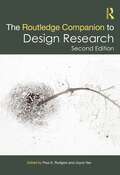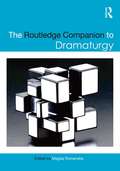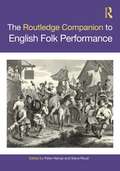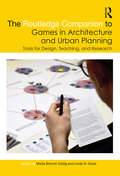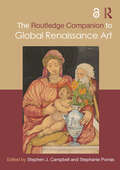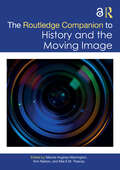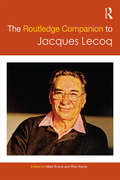- Table View
- List View
The Routledge Companion to Design Research (Routledge Art History and Visual Studies Companions)
This new edition of The Routledge Companion to Design Research offers an updated, comprehensive examination of design research, celebrating a plurality of voices and range of conceptual, methodological, technological and theoretical approaches evident in contemporary design research. This volume comprises thirty-eight original and high-quality design research chapters from contributors around the world, with offerings from the vast array of disciplines in and around modern design praxis, including areas such as industrial and product design, visual communication, interaction design, fashion design, service design, engineering and architecture. The Companion is divided into four distinct sections with chapters that examine the nature and process of design research, the purpose of design research and how one might embark on design research. They also explore how leading design researchers conduct their design research through formulating and asking questions in novel ways, and the creative methods and tools they use to collect and analyse data. The Companion also includes a number of case studies that illustrate how one might best communicate and disseminate design research through contributions that offer techniques for writing and publicising research. The Routledge Companion to Design Research has a wide appeal to researchers and educators in design and design-related disciplines such as engineering, business, marketing, and computing, and will make an invaluable contribution to state-of-the-art design research at postgraduate, doctoral and post-doctoral levels and teaching across a wide range of different disciplines.
The Routledge Companion to Drama in Education
by Mary McAvoyThe Routledge Companion to Drama in Education is a comprehensive reference guide to this unique performance discipline, focusing on its process-oriented theatrical techniques, engagement of a broad spectrum of learners, its historical roots as a field of inquiry and its transdisciplinary pedagogical practices. The book approaches drama in education (DE) from a wide range of perspectives, from leading scholars to teaching artists and school educators who specialise in DE teaching. It presents the central disciplinary conversations around key issues, including best practice in DE, aesthetics and artistry in teaching, the histories of DE, ideologies in drama and education, and concerns around access, inclusivity and justice. Including reflections, lesson plans, programme designs, case studies and provocations from scholars, educators and community arts workers, this is the most robust and comprehensive resource for those interested in DE’s past, present and future.
The Routledge Companion to Drama in Education
by Peter O'Connor Mary McAvoyThe Routledge Companion to Drama in Education is a comprehensive reference guide to this unique performance discipline, focusing on its process-oriented theatrical techniques, engagement of a broad spectrum of learners, its historical roots as a field of inquiry and its transdisciplinary pedagogical practices. The book approaches drama in education (DE) from a wide range of perspectives, from leading scholars to teaching artists and school educators who specialise in DE teaching. It presents the central disciplinary conversations around key issues, including best practice in DE, aesthetics and artistry in teaching, the histories of DE, ideologies in drama and education, and concerns around access, inclusivity and justice. Including reflections, lesson plans, programme designs, case studies and provocations from scholars, educators and community arts workers, this is the most robust and comprehensive resource for those interested in DE’s past, present and future.
The Routledge Companion to Dramaturgy (Routledge Companions)
by Magda RomanskaDramaturgy, in its many forms, is a fundamental and indispensable element of contemporary theatre. In its earliest definition, the word itself means a comprehensive theory of "play making." Although it initially grew out of theatre, contemporary dramaturgy has made enormous advances in recent years, and it now permeates all kinds of narrative forms and structures: from opera to performance art; from dance and multimedia to filmmaking and robotics. In our global, mediated context of multinational group collaborations that dissolve traditional divisions of roles as well as unbend previously intransigent rules of time and space, the dramaturg is also the ultimate globalist: intercultural mediator, information and research manager, media content analyst, interdisciplinary negotiator, social media strategist. This collection focuses on contemporary dramaturgical practice, bringing together contributions not only from academics but also from prominent working dramaturgs. The inclusion of both means a strong level of engagement with current issues in dramaturgy, from the impact of social media to the ongoing centrality of interdisciplinary and intermedial processes. The contributions survey the field through eight main lenses: world dramaturgy and global perspective dramaturgy as function, verb and skill dramaturgical leadership and season planning production dramaturgy in translation adaptation and new play development interdisciplinary dramaturgy play analysis in postdramatic and new media dramaturgy social media and audience outreach. Magda Romanska is Visiting Associate Professor of Slavic Languages and Literatures at Harvard University, Associate Professor of Theatre and Dramaturgy at Emerson College, and Dramaturg for Boston Lyric Opera. Her books include The Post-Traumatic Theatre of Grotowski and Kantor (2012), Boguslaw Schaeffer: An Anthology (2012), and Comedy: An Anthology of Theory and Criticism (2014).
The Routledge Companion to Dramaturgy (Routledge Companions)
by Magda RomanskaDramaturgy, in its many forms, is a fundamental and indispensable element of contemporary theatre. In its earliest definition, the word itself means a comprehensive theory of "play making." Although it initially grew out of theatre, contemporary dramaturgy has made enormous advances in recent years, and it now permeates all kinds of narrative forms and structures: from opera to performance art; from dance and multimedia to filmmaking and robotics. In our global, mediated context of multinational group collaborations that dissolve traditional divisions of roles as well as unbend previously intransigent rules of time and space, the dramaturg is also the ultimate globalist: intercultural mediator, information and research manager, media content analyst, interdisciplinary negotiator, social media strategist. This collection focuses on contemporary dramaturgical practice, bringing together contributions not only from academics but also from prominent working dramaturgs. The inclusion of both means a strong level of engagement with current issues in dramaturgy, from the impact of social media to the ongoing centrality of interdisciplinary and intermedial processes. The contributions survey the field through eight main lenses: world dramaturgy and global perspective dramaturgy as function, verb and skill dramaturgical leadership and season planning production dramaturgy in translation adaptation and new play development interdisciplinary dramaturgy play analysis in postdramatic and new media dramaturgy social media and audience outreach. Magda Romanska is Visiting Associate Professor of Slavic Languages and Literatures at Harvard University, Associate Professor of Theatre and Dramaturgy at Emerson College, and Dramaturg for Boston Lyric Opera. Her books include The Post-Traumatic Theatre of Grotowski and Kantor (2012), Boguslaw Schaeffer: An Anthology (2012), and Comedy: An Anthology of Theory and Criticism (2014).
The Routledge Companion to Ecological Design Thinking: Healthful Ecotopian Visions for Architecture and Urbanism
by Mitra KanaaniThis companion investigates the ways in which designers, architects, and planners address ecology through the built environment by integrating ecological ideas and ecological thinking into discussions of urbanism, society, culture, and design. Exploring the innovation of materials, habitats, landscapes, and infrastructures, it furthers novel ecotopian ideas and ways of living, including human-made settings on water, in outer space, and in extreme environments and climatic conditions. Chapters of this extensive collection on ecotopian design are grouped under five different ecological perspectives: design manifestos and ecological theories, anthropocentric transformative design concepts, design connectivity, climatic design, and social design. Contributors provide plausible, sustainable design ideas that promote resiliency, health, and well-being for all living things, while taking our changing lifestyles into consideration. This volume encourages creative thinking in the face of ongoing environmental damage, with a view to making design decisions in the interest of the planet and its inhabitants. With contributions from over 79 expert practitioners, educators, scientists, researchers, and theoreticians, as well as planners, architects, and engineers from the U.S., Canada, Europe, and Asia, this book engages theory, history, technology, engineering, and science, as well as the human aspects of ecotopian design thinking and its implications for the outlook of the planet.
The Routledge Companion to Ecological Design Thinking: Healthful Ecotopian Visions for Architecture and Urbanism
by Mitra KanaaniThis companion investigates the ways in which designers, architects, and planners address ecology through the built environment by integrating ecological ideas and ecological thinking into discussions of urbanism, society, culture, and design. Exploring the innovation of materials, habitats, landscapes, and infrastructures, it furthers novel ecotopian ideas and ways of living, including human-made settings on water, in outer space, and in extreme environments and climatic conditions. Chapters of this extensive collection on ecotopian design are grouped under five different ecological perspectives: design manifestos and ecological theories, anthropocentric transformative design concepts, design connectivity, climatic design, and social design. Contributors provide plausible, sustainable design ideas that promote resiliency, health, and well-being for all living things, while taking our changing lifestyles into consideration. This volume encourages creative thinking in the face of ongoing environmental damage, with a view to making design decisions in the interest of the planet and its inhabitants. With contributions from over 79 expert practitioners, educators, scientists, researchers, and theoreticians, as well as planners, architects, and engineers from the U.S., Canada, Europe, and Asia, this book engages theory, history, technology, engineering, and science, as well as the human aspects of ecotopian design thinking and its implications for the outlook of the planet.
The Routledge Companion to English Folk Performance (Routledge Companions)
by Peter Harrop Steve RoudThis broad-based collection of essays is an introduction both to the concerns of contemporary folklore scholarship and to the variety of forms that folk performance has taken throughout English history. Combining case studies of specific folk practices with discussion of the various different lenses through which they have been viewed since becoming the subject of concerted study in Victorian times, this book builds on the latest work in an ever-growing body of contemporary folklore scholarship. Many of the contributing scholars are also practicing performers and bring experience and understanding of performance to their analyses and critiques. Chapters range across the spectrum of folk song, music, drama and dance, but maintain a focus on the key defining characteristics of folk performance – custom and tradition – in a full range of performances, from carol singing and sword dancing to playground rhymes and mummers' plays. As well as being an essential reference for folklorists and scholars of traditional performance and local history, this is a valuable resource for readers in all disciplines of dance, drama, song and music whose work coincides with English folk traditions.
The Routledge Companion to English Folk Performance (Routledge Companions)
by Peter Harrop Steve RoudThis broad-based collection of essays is an introduction both to the concerns of contemporary folklore scholarship and to the variety of forms that folk performance has taken throughout English history. Combining case studies of specific folk practices with discussion of the various different lenses through which they have been viewed since becoming the subject of concerted study in Victorian times, this book builds on the latest work in an ever-growing body of contemporary folklore scholarship. Many of the contributing scholars are also practicing performers and bring experience and understanding of performance to their analyses and critiques. Chapters range across the spectrum of folk song, music, drama and dance, but maintain a focus on the key defining characteristics of folk performance – custom and tradition – in a full range of performances, from carol singing and sword dancing to playground rhymes and mummers' plays. As well as being an essential reference for folklorists and scholars of traditional performance and local history, this is a valuable resource for readers in all disciplines of dance, drama, song and music whose work coincides with English folk traditions.
The Routledge Companion to Expressionism in a Transnational Context (Routledge Art History and Visual Studies Companions)
by Isabel WünscheThe Routledge Companion to Expressionism in a Transnational Context is a challenging exploration of the transnational formation, dissemination, and transformation of expressionism outside of the German-speaking world, in regions such as Central and Eastern Europe, the Baltics and Scandinavia, Western and Southern Europe, North and Latin America, and South Africa, in the first half of the twentieth century. Comprising a series of essays by an international group of scholars in the fields of art history and literary and cultural studies, the volume addresses the intellectual discussions and artistic developments arising in the context of the expressionist movement in the various art centers and cultural regions. The authors also examine the implications of expressionism in artistic practice and its influence on modern and contemporary cultural production. Essential for an in-depth understanding and discussion of expressionism, this volume opens up new perspectives on developments in the visual arts of this period and challenges the traditional narratives that have predominantly focused on artistic styles and national movements.
The Routledge Companion to Expressionism in a Transnational Context (Routledge Art History and Visual Studies Companions)
by Isabel WünscheThe Routledge Companion to Expressionism in a Transnational Context is a challenging exploration of the transnational formation, dissemination, and transformation of expressionism outside of the German-speaking world, in regions such as Central and Eastern Europe, the Baltics and Scandinavia, Western and Southern Europe, North and Latin America, and South Africa, in the first half of the twentieth century. Comprising a series of essays by an international group of scholars in the fields of art history and literary and cultural studies, the volume addresses the intellectual discussions and artistic developments arising in the context of the expressionist movement in the various art centers and cultural regions. The authors also examine the implications of expressionism in artistic practice and its influence on modern and contemporary cultural production. Essential for an in-depth understanding and discussion of expressionism, this volume opens up new perspectives on developments in the visual arts of this period and challenges the traditional narratives that have predominantly focused on artistic styles and national movements.
The Routledge Companion to Games in Architecture and Urban Planning: Tools for Design, Teaching, and Research
by Marta Brkovi 263 Dodig Linda GroatThe Routledge Companion to Games in Architecture and Urban Planning aims to identify and showcase the rich diversity of games, including: simulation games, game-like approaches, game scenarios, and gamification processes for teaching/learning, design and research in architecture and urban planning. This collection creates an opportunity for exchange and reflection on games in architecture and urban planning. Theoretical discussions, descriptive accounts, and case studies presenting empirical evidence are featured; combined with reflections, constructive critical analysis, discussions of connections, and various influences on this field. Twenty-eight international contributors have come together from eleven countries and five continents to present their studies on games in architecture and urban planning, pose new questions, and advocate for innovative perspectives.
The Routledge Companion to Games in Architecture and Urban Planning: Tools for Design, Teaching, and Research
by Marta Brković Dodig Linda N. GroatThe Routledge Companion to Games in Architecture and Urban Planning aims to identify and showcase the rich diversity of games, including: simulation games, game-like approaches, game scenarios, and gamification processes for teaching/learning, design and research in architecture and urban planning. This collection creates an opportunity for exchange and reflection on games in architecture and urban planning. Theoretical discussions, descriptive accounts, and case studies presenting empirical evidence are featured; combined with reflections, constructive critical analysis, discussions of connections, and various influences on this field. Twenty-eight international contributors have come together from eleven countries and five continents to present their studies on games in architecture and urban planning, pose new questions, and advocate for innovative perspectives.
Routledge Companion to Global Heritage Conservation
by Vinayak Bharne Trudi SandmeierThe act of identifying, protecting, restoring, and reusing buildings, districts, and built landscapes of historic and cultural significance is, at its best, a reflective and consequential process of urban and socio-economic reform. It has the potential to reconcile conflicting memories, meanings, and cultural tensions, bridging and expanding the perceived boundaries of multiple disciplines towards bigger aspirations of city-making and social justice. How and where do such aspirations overlap and differ across nations and societies across the world? In places with different histories, governance structures, regulatory stringency, and populist dispositions, who are the specific players, and what are the actual processes that bring about bigger and deeper change beyond just the conservation of an architectural or urban entity of perceived value? This collection of scholarly articles by theorists, academics, and practitioners explores the global complexity, guises, and potential of heritage conservation. Going from Tokyo to Cairo, Shenzhen to Rome, and Delhi to Moscow, this volume examines a vast range of topics – indigenous habitats, urban cores, vernacular infrastructure, colonial towns, squatters, burial sites, war zones, and modern landmarks. It surfaces numerous inherent issues – water stress, deforestation, social oppression, poverty, religion, immigration, and polity, expanding the definitions of heritage conservation as both a professional discipline and socio-cultural catalyst. This book argues that the intellectual and praxis limits of heritage conservation – as the agency of reading, defining, and intervening with built heritage – can be expansive, aimed at bigger positive change beyond a specific subject or object; plural, enmeshed with multiple fields and specializations; and empathetic, born from the actual socio-political realities of a place.
Routledge Companion to Global Heritage Conservation
by Vinayak Bharne Trudi SandmeierThe act of identifying, protecting, restoring, and reusing buildings, districts, and built landscapes of historic and cultural significance is, at its best, a reflective and consequential process of urban and socio-economic reform. It has the potential to reconcile conflicting memories, meanings, and cultural tensions, bridging and expanding the perceived boundaries of multiple disciplines towards bigger aspirations of city-making and social justice. How and where do such aspirations overlap and differ across nations and societies across the world? In places with different histories, governance structures, regulatory stringency, and populist dispositions, who are the specific players, and what are the actual processes that bring about bigger and deeper change beyond just the conservation of an architectural or urban entity of perceived value? This collection of scholarly articles by theorists, academics, and practitioners explores the global complexity, guises, and potential of heritage conservation. Going from Tokyo to Cairo, Shenzhen to Rome, and Delhi to Moscow, this volume examines a vast range of topics – indigenous habitats, urban cores, vernacular infrastructure, colonial towns, squatters, burial sites, war zones, and modern landmarks. It surfaces numerous inherent issues – water stress, deforestation, social oppression, poverty, religion, immigration, and polity, expanding the definitions of heritage conservation as both a professional discipline and socio-cultural catalyst. This book argues that the intellectual and praxis limits of heritage conservation – as the agency of reading, defining, and intervening with built heritage – can be expansive, aimed at bigger positive change beyond a specific subject or object; plural, enmeshed with multiple fields and specializations; and empathetic, born from the actual socio-political realities of a place.
The Routledge Companion to Global Photographies (Routledge Art History and Visual Studies Companions)
by Lucy Soutter and Duncan WooldridgeIn response to widespread demand for more knowledge and insight about contemporary photographies beyond Western centers of production and dissemination, this volume provides a transnational discussion, grounded in dialogue between authors and editors from diverse locations and contexts.Ecological and decolonial discourses around photography reveal the medium’s global entanglements: images produced on one side of the globe are the result of labors which span its full surface. At the same time, the multiplicity of approaches and understandings of the photograph reveal that, even though it might seem like a universal language, we utilize its tools to radically different ends. The volume explores issues surrounding cultural translation, photography’s response to climate change, decolonial practices, network formation, new materialities, identities and the role of photobooks. It also provides in-depth surveys and case studies of global practices and theories, alongside interviews and roundtable discussions with key figures whose perspectives illuminate the contemporary field. This groundbreaking collection is an essential resource for academics and students working in or with photography, contextual studies, history, and theory, but also media and cultural studies more broadly.The Open Access version of this book, available at http://www.taylorfrancis.com, has been made available under a Creative Commons Attribution-Non Commercial-No Derivatives (CC-BY-NC-ND) 4.0 license.
The Routledge Companion to Global Photographies (Routledge Art History and Visual Studies Companions)
by Lucy Soutter Duncan WooldridgeIn response to widespread demand for more knowledge and insight about contemporary photographies beyond Western centers of production and dissemination, this volume provides a transnational discussion, grounded in dialogue between authors and editors from diverse locations and contexts.Ecological and decolonial discourses around photography reveal the medium’s global entanglements: images produced on one side of the globe are the result of labors which span its full surface. At the same time, the multiplicity of approaches and understandings of the photograph reveal that, even though it might seem like a universal language, we utilize its tools to radically different ends. The volume explores issues surrounding cultural translation, photography’s response to climate change, decolonial practices, network formation, new materialities, identities and the role of photobooks. It also provides in-depth surveys and case studies of global practices and theories, alongside interviews and roundtable discussions with key figures whose perspectives illuminate the contemporary field. This groundbreaking collection is an essential resource for academics and students working in or with photography, contextual studies, history, and theory, but also media and cultural studies more broadly.The Open Access version of this book, available at http://www.taylorfrancis.com, has been made available under a Creative Commons Attribution-Non Commercial-No Derivatives (CC-BY-NC-ND) 4.0 license.
The Routledge Companion to Global Renaissance Art (Routledge Art History and Visual Studies Companions)
by Stephen J. Campbell Stephanie PorrasThis companion examines the global Renaissance through object-based case studies of artistic production from Africa, Asia, the Americas, and Europe in the early modern period.The international group of contributors take an art historical approach characterized by close analysis of form and meaning as well as function, and a focus on questions of crosscultural dialogue and adaptation. Seeking to de-emphasize the traditional focus on Europe, this book is a critical guide to the literature and the state of the field. Chapters outline new questions and agendas while pushing beyond familiar material. Main themes include workshops, the migrations of artists, objects, technologies, diplomatic gifts, imperial ideologies, ethnicity and indigeneity, sacred spaces and image cults, as well as engaging with the open questions of "the Renaissance" and "the global."This will be a useful and important resource for researchers and students alike and will be of interest to scholars working in art history, visual culture, material culture, and Renaissance studies.The Open Access version of this book, available at www.taylorfrancis.com, has been made available under a Creative Commons [Attribution-Non Commercial-No Derivatives (CC-BY-NC-ND)] 4.0 license
The Routledge Companion to Global Renaissance Art (Routledge Art History and Visual Studies Companions)
This companion examines the global Renaissance through object-based case studies of artistic production from Africa, Asia, the Americas, and Europe in the early modern period.The international group of contributors take an art historical approach characterized by close analysis of form and meaning as well as function, and a focus on questions of crosscultural dialogue and adaptation. Seeking to de-emphasize the traditional focus on Europe, this book is a critical guide to the literature and the state of the field. Chapters outline new questions and agendas while pushing beyond familiar material. Main themes include workshops, the migrations of artists, objects, technologies, diplomatic gifts, imperial ideologies, ethnicity and indigeneity, sacred spaces and image cults, as well as engaging with the open questions of "the Renaissance" and "the global."This will be a useful and important resource for researchers and students alike and will be of interest to scholars working in art history, visual culture, material culture, and Renaissance studies.The Open Access version of this book, available at www.taylorfrancis.com, has been made available under a Creative Commons [Attribution-Non Commercial-No Derivatives (CC-BY-NC-ND)] 4.0 license
The Routledge Companion to History and the Moving Image (Routledge Companions)
by Marnie Hughes-Warrington Kim Nelson Treacey, Mia E.M.The Routledge Companion to History and the Moving Image takes an interdisciplinary approach to understanding history in moving images. It engages this popular and dynamic field that has evolved rapidly from film and television to digital streaming into the age of user-created content.The volume addresses moving image history through a theoretical lens; modes and genres; representation, race, and identity; and evolving forms and formats. It brings together a range of scholars from across the globe who specialize in film and media studies, cultural studies, history, philosophy of history, and education. Together, the chapters provide a necessary contemporary analysis that covers new developments and questions that arise from the shift to digital screen culture. The book examines technological and ethical concerns stemming from today’s media landscape, but it also considers the artificial construction of the boundaries between professional expertise and amateur production. Each contributor’s unique approach highlights the necessity of engaging with moving images for the academic discipline of history.The collection, written for a global audience, offers accessible discussions of historiography and a compelling resource for advanced undergraduates and postgraduates in history, film and media studies, and communications.Both Chapter 17 and the Afterword of this book are freely available as downloadable Open Access PDFs at http://www.taylorfrancis.com under a Creative Commons [Attribution-Non Commercial-No Derivatives (CC-BY-NC-ND)] 4.0 license.
The Routledge Companion to History and the Moving Image (Routledge Companions)
The Routledge Companion to History and the Moving Image takes an interdisciplinary approach to understanding history in moving images. It engages this popular and dynamic field that has evolved rapidly from film and television to digital streaming into the age of user-created content.The volume addresses moving image history through a theoretical lens; modes and genres; representation, race, and identity; and evolving forms and formats. It brings together a range of scholars from across the globe who specialize in film and media studies, cultural studies, history, philosophy of history, and education. Together, the chapters provide a necessary contemporary analysis that covers new developments and questions that arise from the shift to digital screen culture. The book examines technological and ethical concerns stemming from today’s media landscape, but it also considers the artificial construction of the boundaries between professional expertise and amateur production. Each contributor’s unique approach highlights the necessity of engaging with moving images for the academic discipline of history.The collection, written for a global audience, offers accessible discussions of historiography and a compelling resource for advanced undergraduates and postgraduates in history, film and media studies, and communications.Both Chapter 17 and the Afterword of this book are freely available as downloadable Open Access PDFs at http://www.taylorfrancis.com under a Creative Commons [Attribution-Non Commercial-No Derivatives (CC-BY-NC-ND)] 4.0 license.
The Routledge Companion to Indigenous Art Histories in the United States and Canada (Routledge Art History and Visual Studies Companions)
by Heather Igloliorte Carla TauntonThis companion consists of chapters that focus on and bring forward critical theories and productive methodologies for Indigenous art history in North America. This book makes a major and original contribution to the fields of Indigenous visual arts, professional curatorial practice, graduate-level curriculum development, and academic research. The contributors expand, create, establish and define Indigenous theoretical and methodological approaches for the production, discussion, and writing of Indigenous art histories. Bringing together scholars, curators, and artists from across the intersecting fields of Indigenous art history, critical museology, cultural studies, and curatorial practice, the companion promotes the study and dissemination of Indigenous art and stimulates new conversations on such key areas as visual sovereignty and self-determination; resurgence and resilience; land-based, embodied, and nation-specific knowledges; epistemologies and ontologies; curatorial and museological methodologies; language; decolonization and Indigenization; and collaboration, consultation, and mentorship.
The Routledge Companion to Indigenous Art Histories in the United States and Canada (Routledge Art History and Visual Studies Companions)
by Heather Igloliorte Carla TauntonThis companion consists of chapters that focus on and bring forward critical theories and productive methodologies for Indigenous art history in North America. This book makes a major and original contribution to the fields of Indigenous visual arts, professional curatorial practice, graduate-level curriculum development, and academic research. The contributors expand, create, establish and define Indigenous theoretical and methodological approaches for the production, discussion, and writing of Indigenous art histories. Bringing together scholars, curators, and artists from across the intersecting fields of Indigenous art history, critical museology, cultural studies, and curatorial practice, the companion promotes the study and dissemination of Indigenous art and stimulates new conversations on such key areas as visual sovereignty and self-determination; resurgence and resilience; land-based, embodied, and nation-specific knowledges; epistemologies and ontologies; curatorial and museological methodologies; language; decolonization and Indigenization; and collaboration, consultation, and mentorship.
The Routledge Companion to Jacques Lecoq (Routledge Companions)
by Mark Evans Rick KempThe Routledge Companion to Jacques Lecoq presents a thorough overview and analysis of Jacques Lecoq's life, work and philosophy of theatre. Through an exemplary collection of specially commissioned chapters from leading writers, specialists and practitioners, it draws together writings and reflections on his pedagogy, his practice, and his influence on the wider theatrical environment. It is a comprehensive guide to the work and legacy of one of the major figures of Western theatre in the second half of the twentieth century. In a four-part structure over fifty chapters, the book examines: The historical, artistic and social context out of which Lecoq's work and pedagogy arose, and its relation to such figures as Jacques Copeau, Antonin Artaud, Jean-Louis Barrault, and Dario Fo. Core themes of Lecoq's International School of Theatre, such as movement, play, improvisation, masks, language, comedy, and tragedy, investigated by former teachers and graduates of the School. The significance and value of his pedagogical approaches in the context of contemporary theatre practices. The diaspora of performance practice from the School, from the perspective of many of the most prominent artists themselves. This is an important and authoritative guide for anyone interested in Lecoq's work.
The Routledge Companion to Jacques Lecoq (Routledge Companions)
by Mark Evans Rick KempThe Routledge Companion to Jacques Lecoq presents a thorough overview and analysis of Jacques Lecoq's life, work and philosophy of theatre. Through an exemplary collection of specially commissioned chapters from leading writers, specialists and practitioners, it draws together writings and reflections on his pedagogy, his practice, and his influence on the wider theatrical environment. It is a comprehensive guide to the work and legacy of one of the major figures of Western theatre in the second half of the twentieth century. In a four-part structure over fifty chapters, the book examines: The historical, artistic and social context out of which Lecoq's work and pedagogy arose, and its relation to such figures as Jacques Copeau, Antonin Artaud, Jean-Louis Barrault, and Dario Fo. Core themes of Lecoq's International School of Theatre, such as movement, play, improvisation, masks, language, comedy, and tragedy, investigated by former teachers and graduates of the School. The significance and value of his pedagogical approaches in the context of contemporary theatre practices. The diaspora of performance practice from the School, from the perspective of many of the most prominent artists themselves. This is an important and authoritative guide for anyone interested in Lecoq's work.
